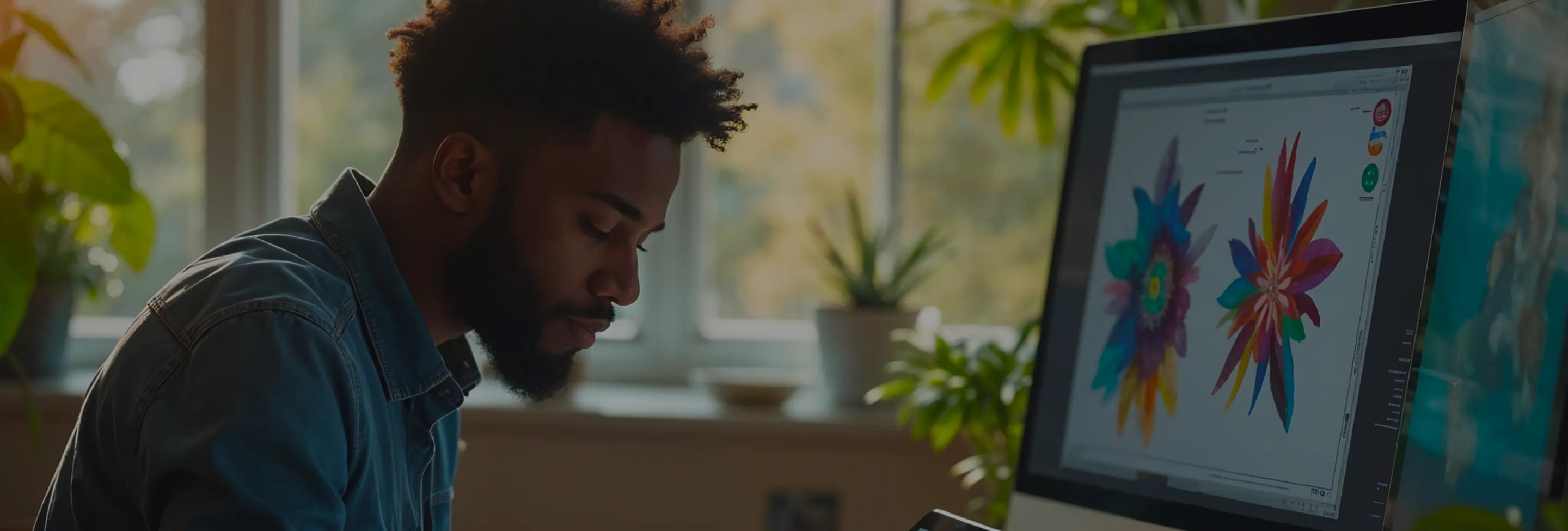
Our review of over 1,500 AI-driven design projects uncovered the top 12 AI infographic questions that address 90% of the common challenges faced by designers and marketers. This guide delves into these critical inquiries, providing clear, actionable answers to enhance your infographic creation process using artificial intelligence.
Answer: An AI infographic leverages artificial intelligence tools to automate, enhance, or personalize the design and data visualization process. Unlike traditional infographics, which rely solely on manual design and data analysis, AI infographics can dynamically generate visuals based on data inputs, adapt to user interactions, and optimize design elements for better engagement.
Example: Using a tool like Canva's AI features, a marketer can input sales data, and the AI will suggest the most effective chart types and color schemes to represent the information clearly and attractively.
Common Misconception: Many believe AI will replace the designer's role entirely. In reality, AI serves as an assistant, handling repetitive tasks and providing suggestions, while designers maintain creative control.
Actionable Solution: Start integrating AI tools into your design workflow to handle data-heavy tasks, allowing you to focus on the creative aspects that require human intuition.
Answer: AI enhances data visualization by automating data analysis, identifying trends, and selecting the most appropriate visualization methods. This reduces the time required to process complex datasets and minimizes human error, ensuring that the visual representation is both accurate and impactful.
Example: Tools like Tableau's AI-powered analytics can automatically detect patterns in data and recommend visualization types that best represent those patterns, such as using a heat map for geographic data distribution.
Actionable Solution: Utilize AI-powered data visualization tools to analyze your data sets and generate initial visual drafts, which you can then refine for clarity and aesthetic appeal.
Troubleshooting Tip: Ensure your data is clean and well-organized before inputting it into AI tools to avoid inaccuracies in the generated visualizations.
Answer: Several AI-powered tools excel in infographic creation, each offering unique features:
Example: Using Canva's AI template suggestions, a user can quickly design an infographic by selecting a layout that best fits their data type and styling preferences.
Actionable Solution: Evaluate different AI infographic tools based on your specific needs, such as data integration capabilities, customization options, and ease of use, to select the one that best fits your project requirements.
Answer: AI algorithms analyze data patterns, user preferences, and design principles to recommend elements such as color schemes, fonts, layouts, and visualization types. They consider factors like readability, visual hierarchy, and audience engagement to optimize the overall design.
Example: An AI tool might suggest a minimalist color palette and sans-serif fonts for a tech industry infographic, recognizing that these elements align with industry standards and audience expectations.
Common Misconception: AI lacks creativity and can only follow predefined rules. In reality, advanced AI can learn from vast datasets to provide innovative design suggestions that align with current trends and user preferences.
Actionable Solution: Leverage AI's design recommendations as a starting point, then apply your creative insights to customize and refine the infographic to better match your brand and message.
Answer: Machine learning algorithms analyze user data and behavior to tailor infographic content and design to specific audience segments. This includes customizing data points, adjusting complexity levels, and modifying visual styles to align with the preferences and needs of different user groups.
Example: A marketing team can use machine learning to create multiple versions of an infographic, each targeting a different demographic, such as one version with simpler visuals for a general audience and another with detailed charts for industry experts.
Actionable Solution: Implement machine learning models that segment your audience based on relevant criteria and automatically generate personalized infographic versions to enhance engagement and comprehension.
Answer: Best practices include:
Example: An AI infographic displaying live social media metrics can update automatically through API integrations, providing real-time insights into engagement trends.
Actionable Solution: Set up robust API connections with your data sources and utilize AI tools that support dynamic data integration to maintain up-to-date and interactive infographics.
Troubleshooting Tip: Regularly monitor API connections and data feeds to prevent interruptions and ensure the infographic remains accurate and functional.
Answer: Common pitfalls include:
Solutions:
Actionable Solution: Establish a workflow where AI handles repetitive tasks and data analysis, while designers focus on adding creative and personalized elements to the infographic.
Answer: Ensure accessibility by:
Example: Using AI features in tools like Visme to check color contrast ratios ensures that the infographic is readable for individuals with visual impairments.
Common Misconception: Accessibility requires extensive manual adjustments. AI can assist significantly by automating accessibility checks and suggesting improvements.
Actionable Solution: Incorporate AI-driven accessibility features into your infographic design process to ensure your visuals are inclusive and user-friendly for all audiences.
Answer: AI-driven interactivity allows users to engage with infographics through features like clickable elements, data filtering, and personalized views. This interactive experience makes the information more engaging and easier to comprehend by allowing users to explore data based on their interests.
Example: An AI-powered infographic on global warming can include interactive maps where users click on different regions to see specific data and related information.
Actionable Solution: Integrate AI tools that support interactive elements into your infographic design, enabling users to interact with the data and customize their viewing experience for better engagement.
Answer: Strategies include:
Example: An AI tool might identify key milestones in a company's growth data and suggest a chronological layout that tells a compelling success story through the infographic.
Actionable Solution: Focus on data-driven storytelling by using AI to identify and highlight the most impactful data points, then craft a narrative that seamlessly integrates these insights into the infographic design.
Highlighted Note: Effective storytelling in infographics not only presents data but also creates a memorable and persuasive narrative that resonates with the audience.
Answer: Common issues include:
Solutions:
Actionable Solution: Implement a data preparation step in your workflow and select AI tools that balance automation with customizable design features to ensure smooth and efficient infographic creation.
Troubleshooting Tip: If encountering performance issues, review and optimize your data sources, and consider simplifying infographic elements to improve loading times.
Answer: Performance can be evaluated through:
Improvement Strategies:
Actionable Solution: Regularly analyze performance data and user feedback to identify areas for improvement, and apply iterative design principles to optimize the effectiveness of your AI-generated infographics.
Integrating AI into infographic creation can significantly enhance accuracy, efficiency, and engagement. By addressing these critical questions and implementing the provided solutions, designers and marketers can leverage AI's full potential to create compelling, data-driven visuals that resonate with their audiences.




Subscribe to our newsletter to receive $100 off your first month of Tapflare's flat rate unlimited design and development service. Your coupon code will be sent to your email.